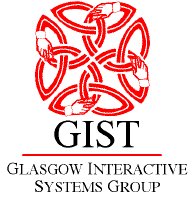 The Multimodal Interaction Group website has moved. Click here to visit the new site
The Multimodal Interaction Group website has moved. Click here to visit the new site
All about Earcons
Earcons were first developed by Blattner, Sumikawa & Greenberg [4], Sumikawa, Blattner, Joy & Greenberg [14], Sumikawa, Blattner & Greenberg [13] and Sumikawa [15]. They use abstract, synthetic tones in structured combinations to create auditory messages. Blattner et al. ([4], p 13) define earcons as non-verbal audio messages that are used in the computer/user interface to provide information to the user about some computer object, operation or interaction. Unlike Gaver's Auditory Icons [73,74,75,76] which use natural, everyday sounds, there is no intuitive link between the sound and what it represents; the link must be learned by the listener. Earcons use a more musical approach than auditory icons. The following sections describe the construction of earcons from smaller units called motives along with descriptions of two different types of earcons. Some issues in learning and remembering earcons are discussed and then some systems that use earcons are given.
Motives
Earcons are constructed from simple building blocks called motives. These are
short, rhythmic sequences of pitches that can be combined in different ways.
Sumikawa et al. ([13], p 5) describe them thus:
A motive is a brief succession of pitches arranged in such a way as to produce a tonal pattern
sufficiently distinct to allow it to function as an individual recognisable entity.
They go on to say:
The eloquence of motives lies in their ability to be
combined to create larger recognisable structures. The repetition of motives,
either exact or varied, or the linking of several different motives produces
larger, more self sufficient patterns. We use these larger structures for earcons.
The most important features of motives are:
- Rhythm: As mentioned in the previous chapter, this is one the most important characteristics of a sound [6] . Changing the rhythm of a motive can make it sound very different. Blattner et al. [4] describe this as the most prominent characteristic of a motive.
- Pitch:There are 96 different pitches in the western musical system and these could be combined to produce a large number of different motives. Sumikawa et al. suggest that random combinations of pitches should not be used, but that they should be taken from one octave for easier manipulation.
- Timbre: Motives can be made to sound different by the use of different timbres, for example playing one motive with the sound of a violin and the other with the sound of a piano. Sine waves can be used to provide colourless sounds (i.e. sounds with no distinct timbre).
- Register: This is the position of the motive in the musical scale. A high register means a high pitched note and a low register a low note. The same motive in a different register can convey a different meaning.
- Dynamics: This is the volume of the motive. It can be made to increase as the motive plays (crescendo) or decrease (decrescendo). A crescendo could be used to give the idea of zooming a window, for example.
Sumikawa [15] defines rhythm and pitch as the fixed parameters of earcons and timbre, register and dynamics as the variable parameters. The fixed parameters are what define a motive, the variable parameters change it. Sumikawa put forward some general guidelines for use in the creation of motives. She gave general rules to follow but few precise instructions. In order to reduce the possible number of combinations of the above parameters, Sumikawa suggested some restrictions. Only seven time divisions should be used when creating rhythms and notes should be kept within a range of eight octaves of twelve notes. Semitone gaps should be avoided as they can create incorrect melodic implications; earcons should be musically neutral. She suggested that only four timbres should be used (sine wave, square wave, sawtooth wave and triangular wave) with three registers (low, medium and high) and a total of five dynamics (soft, medium, loud, soft to loud and loud to soft). Sumikawa said that motives should be no longer than three or four notes or they will become too long for the user to easily remember and may also take too much time to play when in combination. She give little empirical evidence to support many of these restrictions of the parameters. Work described later in this thesis attempts to put forward a more detailed set of guidelines based on experimental results.
Earcon construction
As mentioned above, earcons are constructed from motives. Sumikawa ([15], p 64) suggested some principles to keep in mind when constructing an earcon: It should convey one basic meaning, be brief, simple and distinct from other earcons, and be easy to remember, identify and understand. Unfortunately she gave only general guidelines for creating earcons which means that following the above rules is difficult. She suggested three ways in which motives could be manipulated to create earcons:
- Repetition: Exact restatement of a preceding motive and its parameters.
- Variation: Altering one or more of the variable parameters from the preceding motive.
- Contrast: A decided difference in the pitch and/or rhythmic content from the preceding motive.
These manipulations can be used in different ways. Blattner et al. [4] describe two types of earcons based on them: Compound earcons and family, or hierarchical, earcons.
Prof Stephen Brewster
Department of Computing Science,
University of Glasgow,
Glasgow, G12 8QQ, UK
Tel: +44 (0)141 330 4966
Fax: +44 (0)141 330 4913
Email: stephen@dcs.gla.ac.uk
Last Modified: 31 October 2002